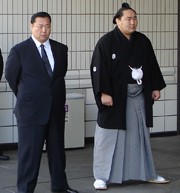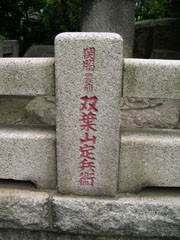| Brothers in Sumo – part two Brian Lewin |

 |
| Yokozuna Comparisons Joe Kuroda |

 |
| Rikishi of Old John Gunning |

 |
| Heya Peek Barbara Ann Klein |

 |
| SFM Interview John Gunning |

 |
| Sumo 101 Barbara Ann Klein |

 |
| Photo Bonanza See the Hatsu Basho |
 |
| Hatsu Basho Review Lon Howard |

 |
| Lower Division Rikishi Mikko Mattila |

 |
| Haru Basho Forecast Pierre Wohlleben & Mark Buckton |

 |
| Kimarite Focus Mikko Mattila |
 |
| Minusha John McTague |
 |
| Online Gaming Alexander Nitschke |

 |
| Kokugi Connections Todd Lambert |

 |
| Fan Debate Feb's debate sees |
 |
SFM Cartoons
Benny Loh & Stephen Thompson
In the third of our cartoon bonanzas, sit back and enjoy BL’s offerings and put a caption to ST’s pic to win yourselves a banzuke
| Let’s Hear From You What was it that |

 |
| Readers’ Letters See what some SFM |

 |
Sumo Quiz
The Quizmaster
Answer the Qs and win yourself next basho’s banzuke.
consecutive-bout winning streak in his fourth makuuchi basho. Walking back after the bout, he was cheered on his way so loudly, and there was so much uproar, that he didn’t even realize that someone had attached a couple of \100 bills to his mawashi.
Now let’s take a brief look at the winning percentage of modern-
era yokozuna in their yokozuna basho. In this list Asashoryu has already joined the elite of the Showa era (1926-1988) by placing right behind Taiho in fourth place.

Kitanoumi (left) the 55th yokozuna and now sumo association chairman stands next to current yokozuna Asashoryu prior to this years hatsu basho. (photo by John Gunning)
The yokozuna careers of both Tamanoumi and the 32nd yokozuna Tamanishiki (1903-1938) were cut short by their untimely deaths, and had they lived longer, their achievement may have been far greater since they were in their prime when they passed away. Tamanishiki and Tamanoumi were known for their stinginess in permitting “Kinboshi,” Tamanishiki only giving away four in 12 yokozuna basho while Tamanoumi gave up 3 in 10 basho at the top.
Table 6 – Most career yusho by yokozuna
| Rank | Yokozuna | Number of Yusho |
|---|---|---|
| 1 | Taiho | 32 |
| 2. | Chiyonofuji | 31 |
| 3. | Kitanoumi | 24 |
| 4. | Takanohana | 22 |
| 5. | Tanikaze | 21 |
A yokozuna’s greatness can be represented in figures by the number of yusho he earns in his career. During the time of Tanikaze, a “yusho” was not awarded and in later years, a yusho was automatically given to the rikishi ranking higher should scores be even, as there was no playoff system in force at
himself, that he has not yet reached his full potential, so is expected to increase his total with the probability of joining this elite list in the near future. All rikishi, except Tanikaze, were from the post-1958 six basho-per-year system. Incidentally, Futabayama had 12 yusho when there were only two basho a year and that, in and of itself, still stands as a significant achievement. Raiden is supposed to have won 27 yusho in the two-basho era, but this is a claim open to dispute.
To be continued.
Next

Futabayama’s name is carved into this stone in Ryogoku. Above his name can be seen the rank of sekiwake. (photo by John Gunning)
